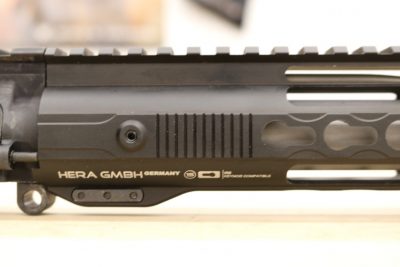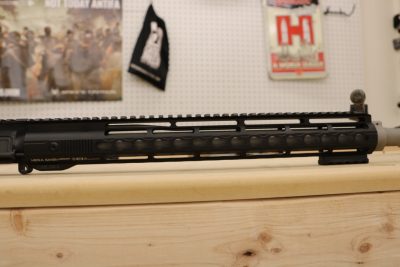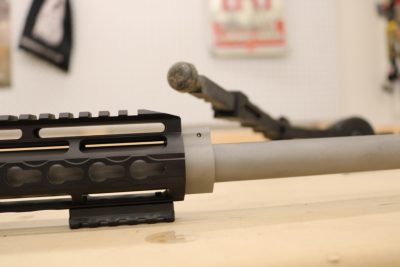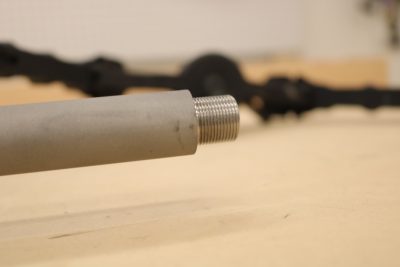It is not often we see a caliber that actually changes the way we think about shooting. Wildcats abound, often with marginal improvement over a factory round at best. There are exceptions, though most calibers fail to catch hold. Even those backed by major players. Several new calibers have been tried in AR-15’s over the past few years, none strong enough to give the rifle new legs. Today, hopefully, that changes.

Back in October, Federal announced the .224 Valkyrie, a revolutionary upgrade for the AR-15. The Valkyrie would share a bolt face diameter with the 6.8 SPC and have an overall length that was capable of firing 90 and 100-grain projectiles from standard magazine size. Recorded from rifle length barrels, Federal states shooters should expect muzzle velocity to be 2,700 feet per second (fps). That is a pretty healthy set of specs. Federal’s claim of supersonic to 1,300 yards set the internet on fire.
Testing the .224 Valkyrie
So, this is not a history of cartridge development. That isn’t my area of expertise. This is a test to see if the Valkyrie delivers, with a brief description of my set up. So first question, should we believe the hype about the bullet? In short, yes. Because the Sierra MatchKing 90 grain isn’t a new bullet. 223 Remington actually uses a .224 bullet, for reasons unknown. But the point is, a .224 inch 90-grain SMK has always been an option for rifles chambered in .223 if they don’t feed from an AR magazine. The ballistic coefficient has been proofed, it actually is very high. Federal says .274 (G7) BC, Applied Ballistics says .257 (G7) BC. Either one makes this an extremely good bullet.

A Further Look At the Case
Secondly, we do have to look at the case a little bit. It matters for durability. Why a 6.8 case head dimension? Because Federal has been making 6.8 SPC for a foreign military customer for many years, therefore they have lots of data. Some of the other AR calibers that came down the pipe had a bad habit of shearing bolt lugs. This had less to do with higher pressures and more to do with the machining of the bolt lugs. Taking material away from the bolt face doesn’t just change the amount of steel, it changes the way heat treat affects those parts. The first question I asked the Federal Ammunition Manager was about the lugs. He assured me that the pressures are similar to 6.8 SPC, and 6.8 did not suffer that problem. So that gives us two in the positive category.

Getting Ready for Field Testing
The Valkyrie fits a standard AR-15, with a bolt, barrel, and magazine swap. Magazines were easy, a 6.8 SPC will work. I called a buddy at Gunmagwarehouse.com, and he sent me an ASC brand. There aren’t that many 6.8 makers around, but I bet that rapidly changes. The bolt, again not a problem. LWRC makes bolts, and they fit an AR carrier group.
Now to find an upper, that was a quest. When you are testing a new round, you can’t just slapdash some lowest bidder parts together and call that data. If I said the Valkyrie was inaccurate and slow because I tested it with a bargain bin factory upper, people would justifiably call bullshit. To test the accuracy of a cartridge, you must rule out all other variables. A totally new round, with the claims Federal was making, deserved a legitimate rifle to be judged by. So there was only one thing to do. I reached out to Craddock Precision, in Lexington, Illinois. Craddock Precision has a reputation for extremely good builds, using only top shelf blanks and parts. Their customer list includes some absolute legends in long range. They were already in the .224 Valkyrie game, so it was off to the races.
***Read Patrick Kelley’s in-depth review of the Savage MSR15 in .224 Valkryie.***
The upper returned to me is an absolute work of art. The barrel is a 22-inch, match grade, 1:7 Criterion, cut in-house. It is a “medium-heavy” profile, in keeping with the precision requirement I had. The handguard is a German made Hera KeyMod, which fits like a glove. As an added bonus, I had them thread it in a 5/8x 24 pitch, so I can use 7.62 suppressors in future testing. That is one of the really nice things about going to a custom shop, they can build to any spec you like.
[one_half] [/one_half][one_half_last]
[/one_half][one_half_last] [/one_half_last]
[/one_half_last]
[one_half] [/one_half][one_half_last]
[/one_half][one_half_last] [/one_half_last]
[/one_half_last]
Rounding out the package, a lower with an AR Gold trigger, my standard for everything. With an out of the box crisp 3.0 pound break, it is mandatory like Metallica for accuracy testing. Coupled with a Magpul PRS stock and a Vortex Razor HD II on top, I couldn’t have asked for a better set up.
Range Time
The first thing you notice about the Valkyrie is how soft it recoils. Spotting your impacts is easy. The second thing I noticed, was how much I like my Craddock upper. It took about 20 rounds to get the barrel settled in, something to be expected when installing a new barrel. It takes a minute for your barrel to find its sweet spot, something you also no doubt notice if you clean the copper out completely with copper solvent. For those first 20 rounds, the Craddock turned in paltry .6 and .7 inch 100-yard groups. After a little break in, it shrank to .34 inches, which is one of the tightest I have shot. I have no doubt there is a little more in there, it just might take a better shooter to get it.

I didn’t have a mountain of bullets for play time, and Valkyrie isn’t one you can just grab at the gas station, at least not yet. So I did the only sensible thing and moved straight back to 1,027 yards. Federal says supersonic to 1,300, but 1,027 seemed a prudent compromise for truing the muzzle velocity. I wasn’t disappointed. It took a couple of walk-on rounds to find the difference between alleged velocity and known velocity, yielding another surprise. My muzzle velocity was 2,760, and the Valkyrie fought the wind better than I would’ve guessed. Dope trued, I smashed three into a B/C zone target with ease for a group. Between the soft recoil and the excellent BC, this was the easiest 1,000 yard shooting I have ever done.

Going the Distance
The thousand was so easy, it seemed like a good idea to move straight back to a mile. That is passed even the most optimistic supersonic estimate, but exactly what I was looking for. One mile has become the new test, as bullets and rifles improve. The group the Valkyrie had just given me proves that shooting 1,000 yards isn’t all that impressive anymore. Moving into subsonic range teaches us a lot, even if it presents other problems.
With the use of ballistic computers, everything inside supersonic becomes easy. ( Except the wind call, that still separates the men from the boys.) Once we have a trued muzzle velocity, everything within supersonic range becomes a known quantity. The same is actually true in the subsonic range. We can predict that too. The unknown part is the transonic range, where the bullet is passing from super to subsonic. That is when, in scientific terms, “ weird shit happens.” Bullets wobble on axis, flight gets screwy, and it is very hard to predict. About the only thing we still have to shoot for DOPE purposes is that transonic region. Also, some bullets survive it better than others. And I really wanted to see if the 224 was a survivor.
Article Continues Below
1 Mile
So we went out to a mile. Even here in Idaho, God’s Country, finding a mile with a backstop isn’t the easiest thing to do. I located a spot, but with less than ideal circumstances. When I am testing a new round at ranges like this, I prefer a rock background. It makes it easier to see the splash, so you can fix your firing solution. The second best option is dust. I had neither. It had just rained, and a rocky spot with a mile reach didn’t turn up. So I settled in to try anyway.

One mile also starts really playing hell with your ability to see. 224 Valkyrie is an awesome round, but it isn’t magic. Well, maybe it is a little bit magic. But it is still running out of energy quick at 1,760 yards. It took a few rounds to find my correct elevation, with little tiny puffs of mud to spot. After I got the DOPE right, I shot five rounds at steel. It barely chipped the paint, but two landed. There was so little movement of the target I actually had to drive down to see it, still believing I had shanked all five. They might’ve barely chipped the paint, but two hits were visible. The most telling part, they were both on the left side of the target. The wind was from my left, odds are pretty good I overestimated the wind drift on the other three. Wow. Just wow.
Lasting Impressions
From initial testing, the Valkyrie is the little engine that could. It is soft shooting, accurate as hell, and the price is right. Environment affects what the speed of sound is, but for my conditions, my bullet went subsonic around 1250 yards. Just shy of the Federal claim of 1300, but close enough to count. The bullet made hits at a mile, and I have never done that with a small frame AR. In fact, the smallest caliber I have achieved that with to date is 308. From what I see, the 224 Valkyrie is a Creedmoor for small guns. And the potential is staggering.
For more information about Federal ammunition, click here.
***Check out GunsAmerica for your next rifle chambered in .224 Valkeryie.***